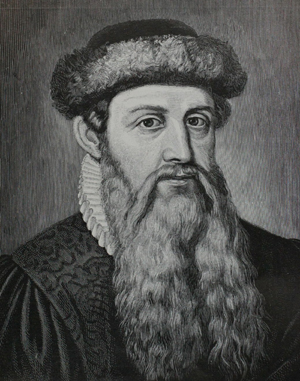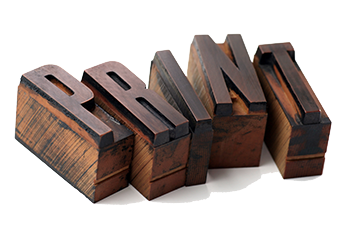Print was a revolutionary development. Johannes Gutenberg invented movable type in 1439 and literally changed the world, opening new opportunities to share information that laid the grounds for the industrial revolution and a continually accelerating process of technological change that continues even today.

Johannes himself (Wikimedia Commons)
Of course, Thomas Press hasn’t been around since the 15th century, but we’ve helped individuals and businesses in Waukesha share information since 1906. Print played a major role in the developments of the 20th century, and it’s still a very relevant communications channel today.
The 20th century was the age of communication. The availability of telephone service, radio, and then TV changed the way that people communicated with one another. Even with the development of “mass media” in the latter half of the 1900s, print remained a very important part of the communications mix. Print was (and is) durable, economical, and portable.
If only our building could talk, we’d be able to track the recent history of our community by the projects that went through the doors of Thomas Press. In Waukesha and throughout the US, organizations depended on print for a broad range of purposes. They used forms and receipts to record transactions, letterhead and envelopes for correspondence, brochures, handbills, and flyers for promotion. Print was used for packaging, for advertisement, for information, and even to reproduce works of art.
Print capabilities evolved steadily during the 20th century, and Thomas Press modernized with the industry, adding capabilities that increased efficiency and reduced costs. The original Thomas Press was primarily a letterpress operation – we still have some of the old type cabinets from the days when each letter was set by hand. As the century progressed, the company added linotype machinery and moved to hot metal typesetting, then to offset lithography and printing plates in the 1950s and 60s.
The digital age came at the end of the century and brought more massive change and improvements that met the changing needs of our clients. Thomas Press added copying capabilities in the 1980s. Desktop publishing and came around in the early 1990s, followed shortly after by computer-to-plate systems for offset printing and then the digital presses that we used today.
Print in the Digital Age
The 20th century was a golden age for the printing industry and for Thomas Press, but the development of the internet in the 1990s and the multiplication of digital communications channels in the first years of the new century brought challenges for printers and a new role for print. The 21st century brought a new reality – Print remains a vital way to communicate, but it’s not the only choice for modern businesses.
The printing industry has adapted. Many small printing companies closed their doors and others consolidated or specialized in a particular area of for a group of customers. Thomas Press focused on the needs of our customers, filling market demand for a reliable local printing company in Waukesha and the Milwaukee area that could respond quickly with an extensive selection of printed products.
Where Print Fits Today
Even with the availability of digital communications channels, print continues to have significant value for a few very good reasons:

What does this mean for you?
If you need to convey details or get the message across, print is the best media to use. It’s simple: People remember print. Want to learn some more? Read about Where Print Works, and Why.

